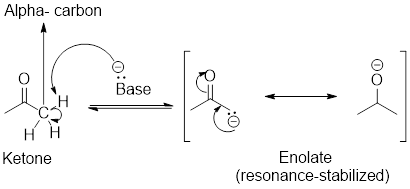
Organic Chemistry, Third Edition Binder Ready Version
3rd Edition
ISBN: 9781119110453
Author: Klein
Publisher: WILEY
expand_more
expand_more
format_list_bulleted
Concept explainers
Question
Chapter 21.1, Problem 5ATS
Interpretation Introduction
Interpretation:
For Ethyl diethoxyacetate, the resonance structures have to be drawn.
Concept Introduction:
Enolates:
When
Example:

Expert Solution & Answer
Want to see the full answer?
Check out a sample textbook solution
Students have asked these similar questions
Draw the major product of this reaction. Ignore inorganic
byproducts.
Incorrect, 3 attempts remaining
1. excess Br2, NaOH
2. neutralizing workup
Q
Given the electrode Pt | Ag | Ag+ (aq), describe it.
At 25°C, the reaction Zn2+ + 2e ⇄ Zn has a normal equilibrium potential versus the saturated calomel electrode of -1.0048 V. Determine the normal equilibrium potential of Zn versus the hydrogen electrode.Data: The calomel electrode potential is E° = 0.2420 V versus the normal hydrogen electrode.
Chapter 21 Solutions
Organic Chemistry, Third Edition Binder Ready Version
Ch. 21.1 - Prob. 1CCCh. 21.1 - Prob. 2CCCh. 21.1 - Prob. 3CCCh. 21.1 - Prob. 1LTSCh. 21.1 - Prob. 4PTSCh. 21.1 - APPLY the skill
As with aldehydes and ketones, the...Ch. 21.1 - Draw the enolate ion that is formed when each of...Ch. 21.1 - Prob. 7CCCh. 21.2 - Prob. 8CCCh. 21.2 - Prob. 9CC
Ch. 21.2 - Prob. 10CCCh. 21.2 - Prob. 11CCCh. 21.2 - Prob. 12CCCh. 21.2 - Prob. 13CCCh. 21.3 - Prob. 2LTSCh. 21.3 - Prob. 14PTSCh. 21.3 - Prob. 15PTSCh. 21.3 - Prob. 16ATSCh. 21.3 - Prob. 3LTSCh. 21.3 - Prob. 17PTSCh. 21.3 - Prob. 18ATSCh. 21.3 - Prob. 4LTSCh. 21.3 - Prob. 19PTSCh. 21.3 - Prob. 20ATSCh. 21.3 - Prob. 21CCCh. 21.3 - Prob. 22CCCh. 21.3 - Prob. 23CCCh. 21.4 - Prob. 24CCCh. 21.4 - Prob. 25CCCh. 21.4 - Prob. 26CCCh. 21.4 - Prob. 27CCCh. 21.4 - Prob. 28CCCh. 21.5 - Prob. 29CCCh. 21.5 - Prob. 30CCCh. 21.5 - Prob. 5LTSCh. 21.5 - Prob. 31PTSCh. 21.5 - Prob. 32ATSCh. 21.5 - Prob. 6LTSCh. 21.5 - Prob. 33PTSCh. 21.5 - Prob. 34ATSCh. 21.6 - Prob. 35CCCh. 21.6 - Prob. 36CCCh. 21.6 - Prob. 37CCCh. 21.6 - Prob. 7LTSCh. 21.6 - Prob. 38PTSCh. 21.6 - Prob. 39ATSCh. 21.6 - Prob. 40CCCh. 21.6 - Prob. 41CCCh. 21.7 - Prob. 8LTSCh. 21.7 - Prob. 42PTSCh. 21.7 - Prob. 43PTSCh. 21.7 - Prob. 9LTSCh. 21.7 - Prob. 45PTSCh. 21.7 - Prob. 46ATSCh. 21 - Prob. 47PPCh. 21 - Prob. 48PPCh. 21 - Prob. 49PPCh. 21 - Prob. 50PPCh. 21 - Prob. 51PPCh. 21 - Prob. 52PPCh. 21 - Prob. 53PPCh. 21 - Prob. 54PPCh. 21 - Prob. 55PPCh. 21 - Prob. 56PPCh. 21 - Prob. 57PPCh. 21 - Prob. 58PPCh. 21 - Prob. 59PPCh. 21 - Prob. 60PPCh. 21 - Prob. 61PPCh. 21 - Prob. 62PPCh. 21 - Prob. 63PPCh. 21 - Prob. 64PPCh. 21 - Prob. 65PPCh. 21 - Prob. 66PPCh. 21 - Prob. 67PPCh. 21 - Prob. 68PPCh. 21 - Prob. 69PPCh. 21 - Prob. 70PPCh. 21 - Prob. 71PPCh. 21 - Prob. 72PPCh. 21 - Prob. 73PPCh. 21 - Prob. 74PPCh. 21 - Prob. 75PPCh. 21 - Prob. 76PPCh. 21 - Prob. 77PPCh. 21 - Prob. 78PPCh. 21 - Prob. 79PPCh. 21 - Prob. 80PPCh. 21 - Prob. 81PPCh. 21 - Prob. 82PPCh. 21 - Prob. 83PPCh. 21 - Prob. 84PPCh. 21 - Prob. 85PPCh. 21 - Prob. 86PPCh. 21 - Prob. 87PPCh. 21 - Prob. 88PPCh. 21 - Prob. 89IPCh. 21 - Prob. 90IPCh. 21 - Prob. 91IPCh. 21 - Prob. 92IPCh. 21 - Prob. 93IPCh. 21 - Prob. 94IPCh. 21 - Prob. 95IPCh. 21 - Prob. 96IPCh. 21 - Prob. 97IPCh. 21 - Prob. 98IPCh. 21 - Prob. 99IPCh. 21 - Prob. 100IPCh. 21 - Prob. 101IPCh. 21 - Prob. 102IPCh. 21 - Prob. 103IPCh. 21 - Prob. 104IPCh. 21 - Prob. 105IPCh. 21 - Prob. 106IPCh. 21 - Prob. 107IPCh. 21 - Prob. 108IPCh. 21 - Prob. 109IPCh. 21 - Prob. 110IPCh. 21 - Prob. 111IPCh. 21 - Prob. 112IPCh. 21 - Prob. 113IPCh. 21 - Prob. 114IPCh. 21 - Prob. 115IPCh. 21 - Prob. 116CPCh. 21 - Prob. 117CPCh. 21 - Prob. 118CP
Knowledge Booster
Learn more about
Need a deep-dive on the concept behind this application? Look no further. Learn more about this topic, chemistry and related others by exploring similar questions and additional content below.Similar questions
- Electrochemistry. State the difference between E and E0.arrow_forwardIn an electrolytic cell, the positive pole is always assumed to be on the right side of the battery notation. Is that correct?arrow_forwardIn an electrolytic cell, the positive pole is always assumed to be on the right side of the battery. Is that correct?arrow_forward
- Calculate the free energy of formation of 1 mol of Cu in cells where the electrolyte is 1 mol dm-3 Cu2+ in sulfate solution, pH 0. E° for the Cu2+/Cu pair in this medium is +142 mV versus ENH.Assume the anodic reaction is oxygen evolution.Data: EH2 = -0.059 pH (V) and EO2 = 1.230 - 0.059 pH (V); 2.3RT/F = 0.059 Varrow_forwardIf the normal potential for the Fe(III)/Fe(II) pair in acid at zero pH is 524 mV Hg/Hg2Cl2 . The potential of the saturated calomel reference electrode is +246 mV versus the NHE. Calculate E0 vs NHE.arrow_forwardGiven the galvanic cell whose scheme is: (-) Zn/Zn2+ ⋮⋮ Ag+/Ag (+). If we know the normal potentials E°(Zn2+/Zn) = -0.76V and E°(Ag+/Ag) = 0.799 V. Indicate the electrodes that are the anode and the cathode and calculate the E0battery.arrow_forward
- Indicate the functions that salt bridges have in batteries.arrow_forwardIn the battery:Pt | H2 (g) | H+ (aq) | Fe2+ (aq) | FeIndicate the cathode and anode.arrow_forwardWrite the equations that occur when the electrode Pb (s) | PbI2 (s) | KI (ac) in a galvanic cell. a) It functions as a positive electrode b) It functions as a negative electrode c) What is the ion with respect to which this electrode is reversible?arrow_forward
- State the formula to find the electromotive force of a battery as a function of the potential of the anode and the cathode.arrow_forwardWhy are normal electrode potentials also called relative electrode potentials?arrow_forwardEasily differentiate between electrochemical potential and Galvani potential.arrow_forward
arrow_back_ios
SEE MORE QUESTIONS
arrow_forward_ios
Recommended textbooks for you
 ChemistryChemistryISBN:9781305957404Author:Steven S. Zumdahl, Susan A. Zumdahl, Donald J. DeCostePublisher:Cengage Learning
ChemistryChemistryISBN:9781305957404Author:Steven S. Zumdahl, Susan A. Zumdahl, Donald J. DeCostePublisher:Cengage Learning ChemistryChemistryISBN:9781259911156Author:Raymond Chang Dr., Jason Overby ProfessorPublisher:McGraw-Hill Education
ChemistryChemistryISBN:9781259911156Author:Raymond Chang Dr., Jason Overby ProfessorPublisher:McGraw-Hill Education Principles of Instrumental AnalysisChemistryISBN:9781305577213Author:Douglas A. Skoog, F. James Holler, Stanley R. CrouchPublisher:Cengage Learning
Principles of Instrumental AnalysisChemistryISBN:9781305577213Author:Douglas A. Skoog, F. James Holler, Stanley R. CrouchPublisher:Cengage Learning Organic ChemistryChemistryISBN:9780078021558Author:Janice Gorzynski Smith Dr.Publisher:McGraw-Hill Education
Organic ChemistryChemistryISBN:9780078021558Author:Janice Gorzynski Smith Dr.Publisher:McGraw-Hill Education Chemistry: Principles and ReactionsChemistryISBN:9781305079373Author:William L. Masterton, Cecile N. HurleyPublisher:Cengage Learning
Chemistry: Principles and ReactionsChemistryISBN:9781305079373Author:William L. Masterton, Cecile N. HurleyPublisher:Cengage Learning Elementary Principles of Chemical Processes, Bind...ChemistryISBN:9781118431221Author:Richard M. Felder, Ronald W. Rousseau, Lisa G. BullardPublisher:WILEY
Elementary Principles of Chemical Processes, Bind...ChemistryISBN:9781118431221Author:Richard M. Felder, Ronald W. Rousseau, Lisa G. BullardPublisher:WILEY

Chemistry
Chemistry
ISBN:9781305957404
Author:Steven S. Zumdahl, Susan A. Zumdahl, Donald J. DeCoste
Publisher:Cengage Learning

Chemistry
Chemistry
ISBN:9781259911156
Author:Raymond Chang Dr., Jason Overby Professor
Publisher:McGraw-Hill Education

Principles of Instrumental Analysis
Chemistry
ISBN:9781305577213
Author:Douglas A. Skoog, F. James Holler, Stanley R. Crouch
Publisher:Cengage Learning

Organic Chemistry
Chemistry
ISBN:9780078021558
Author:Janice Gorzynski Smith Dr.
Publisher:McGraw-Hill Education

Chemistry: Principles and Reactions
Chemistry
ISBN:9781305079373
Author:William L. Masterton, Cecile N. Hurley
Publisher:Cengage Learning

Elementary Principles of Chemical Processes, Bind...
Chemistry
ISBN:9781118431221
Author:Richard M. Felder, Ronald W. Rousseau, Lisa G. Bullard
Publisher:WILEY
Enzymes - Effect of cofactors on enzyme; Author: Tutorials Point (India) Ltd;https://www.youtube.com/watch?v=AkAbIwxyUs4;License: Standard YouTube License, CC-BY
Enzyme Catalysis Part-I; Author: NPTEL-NOC IITM;https://www.youtube.com/watch?v=aZE740JWZuQ;License: Standard Youtube License